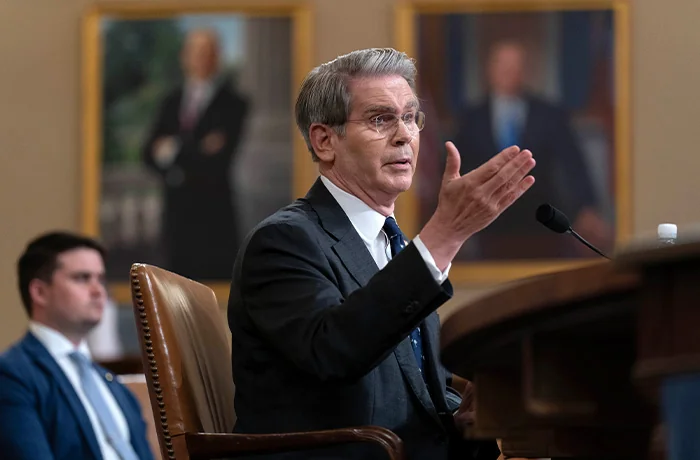Since the start of President Donald Trump‘s second term, the weight of the world, or at least of global markets, international trade, and geopolitical relations, has fallen on the shoulders of Treasury Secretary Scott Bessent, whose portfolio spans everything from China tariffs to bond auctions.
But Bessent’s toughest negotiating partner is probably not Chinese President Xi Jinping, the European Union, or any other foreign power. Instead, Bessent’s most formidable foe is Congress, and the contest is his race to finance the national debt.
In a recent House Ways and Means Committee hearing, Bessent correctly took a victory lap over Trump 2.0’s fiscal performance thus far.
“Critics of the President’s efforts to modernize the IRS warned that the effort would result in a 10% shortfall in receipts,” Bessent said. “Instead, the opposite happened: April receipts this year were up 9.5% over the previous year, and receipts in May were up 14.7% over the previous year.”

Even without Trump’s “one big, beautiful bill,” which is still pending Senate approval, the Treasury Department has done an exceptional job of bringing the ballooning national debt to a halt. From the start of Trump’s presidency, total national debt held by the public has only increased by 0.26%, compared to a 2.24% increase in the same window of time in 2024, when former President Joe Biden held the White House. The total fiscal surplus of April 2025 was 22% higher than April 2024, and the deficit of May 2025 was 15% lower than May 2024.
But Bessent is still constrained by the looming deadline and the arguable raison d’être of the modern-day treasury secretary: the debt ceiling.
While Congress does not constrain the Treasury’s ability to spend, it does limit its ability to borrow. Under Article I, Section 8 of the Constitution, Congress must specifically authorize the amount of debt the government can issue. For the first century and a half after the nation’s founding, the “debt ceiling” did not exist because Congress authorized every individual piece of debt the Treasury ever issued. Only with World War II and the dramatic expansion of federal spending did Congress translate its debt-issuing authority into an aggregate debt ceiling.
When Trump entered office, the government had already hit the $36.1 trillion debt ceiling. But the “X-date” — the point at which the government would have to default on legally mandated obligations — wasn’t projected to come until June. So-called extraordinary measures by the treasury secretary, such as suspending investments in the pensions of federal retirees, were estimated to buy Trump at least five months before Congress would have to raise the debt ceiling.
But under Bessent’s extraordinary management, the Congressional Budget Office postponed that projected X-date to “between mid-August and the end of September 2025.”
Still, the bill comes due. The House version of the reconciliation bill would increase the debt ceiling by $4 trillion, but fiscal hawks such as Sen. Rand Paul (R-KY) have threatened to vote against any version that raises the debt ceiling by $500 billion, or what Congress spends in a matter of months. So, what is the right amount?
Well, it is indeed a financially arbitrary amount. Paul’s real gambit isn’t that we’ll only spend $500 billion in the future, but rather that punting the debt ceiling debate until after the enactment of the “one big, beautiful bill” could allow him a second shot at securing spending reductions.
In theory, using the threat of refusing to increase the debt ceiling until the government is forced to default on its national debt is akin to refusing to pay your Amex bill. In both cases, the debt crisis is created when Congress or a spendthrift swipes the charge card in question, not when the inevitable bill comes due. As Bessent has reiterated, the debt ceiling must be raised simply because failure is not an option. An actual default on our national debt would raise the cost of borrowing to apocalyptic rates that would end the Treasury’s status as a global safe haven for good.
But in practice, the threat of refusing to pay that bill does constrain future spending. As the economist now known as Jessica Riedl explained, all eight of the largest deficit-reduction laws of the past 40 years have been attached to debt-limit bills.
“Debt-limit ‘showdowns’ were relatively rare because both sides recognized the need to include fiscal reforms,” Riedl said.
BIDEN AUTOPEN USE IN DC WAS MORE WIDESPREAD THAN PREVIOUSLY KNOWN
Now, neither party heeds such wisdom, forcing the rare remaining budget hawks, such as Paul, to milk the moment for all the spending concessions he can extract (or extort, depending on your perspective).
Bessent isn’t just buying time for Trump. By delaying the X-date beyond his July 4 deadline for Congress to deliver the reconciliation to Trump’s desk, Bessent is implicitly allowing the fiscal hawks a shot at using a later debt limit debate for spending concessions rather than keeping it a live grenade to allow Democrats to dilute the “one big, beautiful bill.” But in the end, Congress will bend to Bessent, and he, in turn, will keep American bonds and bills the gold standard of global finance.























